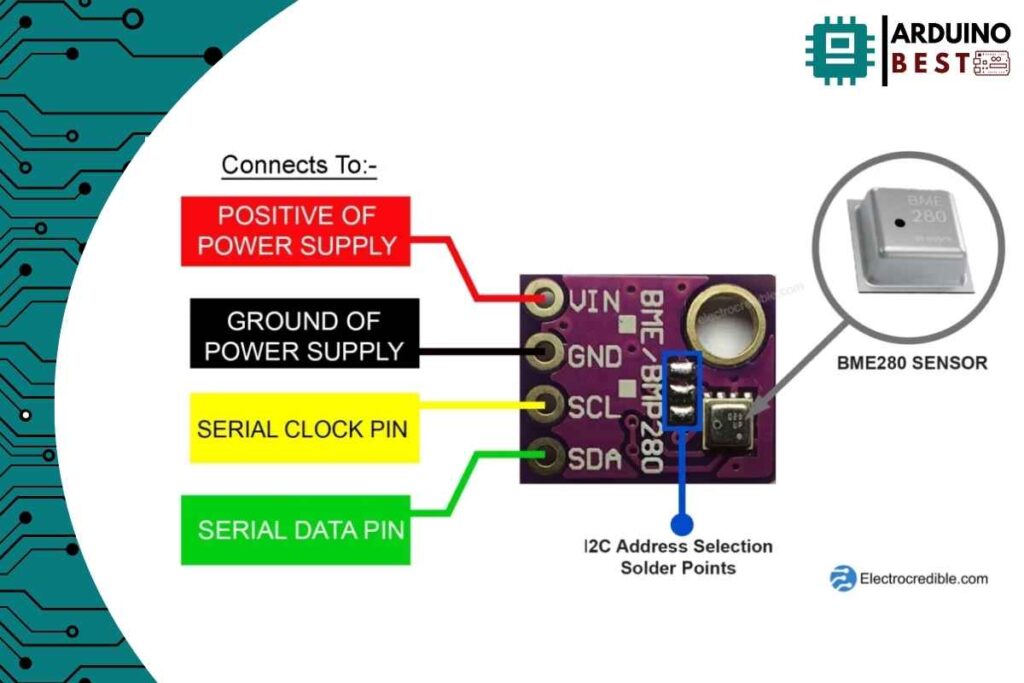Introduction
Table of Contents
Environmental sensors play a critical role in monitoring atmospheric conditions for various applications, from weather forecasting to smart home automation. One of the most versatile and widely used sensors in this category is the BME280 sensor, developed by Bosch Sensortec.
This compact and efficient sensor measures temperature, humidity, and barometric pressure with high accuracy, making it an essential component for IoT (Internet of Things) applications, environmental monitoring, and wearable devices. Whether you’re a hobbyist working with Arduino or Raspberry Pi, or a professional developing a large-scale monitoring system, the BME280 sensor provides precise and reliable data.

What is the BME280 Sensor?
The BME280 is a digital environmental sensor designed for low-power and high-precision measurement of:
- Temperature (range: -40°C to +85°C, accuracy: ±1°C)
- Humidity (range: 0% to 100% RH, accuracy: ±3% RH)
- Pressure (range: 300–1100 hPa, accuracy: ±1 hPa)
This sensor is widely used in applications such as weather stations, altitude tracking, indoor air quality monitoring, and industrial automation.
To learn more about the BME280’s official specifications, visit Bosch Sensortec’s product page.
Key Features of the BME280 Sensor
The BME280 stands out due to its advanced features:
- Compact design – Small footprint for integration in various devices
- Low power consumption – Ideal for battery-powered applications
- High accuracy and resolution – Ensures precise data collection
- Multiple communication interfaces – Supports both I²C and SPI protocols
- Fast response time – Quickly adapts to environmental changes
For an in-depth comparison with other sensors, check out this detailed technical breakdown.
Technical Specifications
| Parameter | Specification |
|---|---|
| Temperature Range | -40°C to +85°C |
| Temperature Accuracy | ±1°C |
| Humidity Range | 0% to 100% RH |
| Humidity Accuracy | ±3% RH |
| Pressure Range | 300–1100 hPa |
| Pressure Accuracy | ±1 hPa |
| Communication Protocols | I²C, SPI |
| Power Consumption | Ultra-low (<1.8µA) |
Communication Interfaces: I²C vs SPI
The BME280 sensor supports two communication protocols:
- I²C (Inter-Integrated Circuit):
- Requires only two wires for communication (SDA, SCL)
- Suitable for low-speed applications
- Ideal for simple connections to microcontrollers like Arduino
- SPI (Serial Peripheral Interface):
- Faster data transmission
- Requires four wires (MOSI, MISO, SCLK, CS)
- Preferred for high-speed applications
Applications of the BME280 Sensor
The BME280 is used in various domains, including:
- Weather stations – Provides real-time environmental data
- Indoor air quality monitoring – Measures humidity for HVAC systems
- Altitude tracking – Used in drones and wearable fitness devices
- Smart home automation – Adjusts climate control settings automatically
- Industrial automation – Helps maintain optimal conditions in factories
Integrating the BME280 with Microcontrollers
The BME280 is widely used with Arduino and Raspberry Pi for DIY projects and prototyping.
Basic Steps to Connect with Arduino
- Connect VCC to 3.3V
- Connect GND to GND
- Connect SDA to A4 (Arduino I²C data pin)
- Connect SCL to A5 (Arduino I²C clock pin)
- Use libraries like Adafruit BME280 to read sensor data
Sample Arduino Code:
#include <Wire.h>
#include <Adafruit_BME280.h>
Adafruit_BME280 bme;
void setup() {
Serial.begin(115200);
if (!bme.begin(0x76)) {
Serial.println("Could not find a valid BME280 sensor!");
while (1);
}
}
void loop() {
Serial.print("Temperature = "); Serial.print(bme.readTemperature()); Serial.println(" °C");
Serial.print("Humidity = "); Serial.print(bme.readHumidity()); Serial.println(" %");
Serial.print("Pressure = "); Serial.print(bme.readPressure() / 100.0F); Serial.println(" hPa");
delay(2000);
}
Calibration and Accuracy Considerations
- The BME280 is factory calibrated, meaning it does not require additional user calibration.
- Factors that may affect accuracy:
- Sensor placement (avoid heat sources)
- Ventilation (ensure proper airflow for humidity measurement)
- Altitude compensation for accurate pressure readings
BME280 vs Other Sensors
| Feature | BME280 | BMP280 | DHT22 |
|---|---|---|---|
| Measures Temperature | ✅ | ✅ | ✅ |
| Measures Humidity | ✅ | ❌ | ✅ |
| Measures Pressure | ✅ | ✅ | ❌ |
| Communication | I²C, SPI | I²C, SPI | Single-wire |
| Accuracy (Temp) | ±1°C | ±1°C | ±2°C |
| Accuracy (Humidity) | ±3% RH | N/A | ±5% RH |
Power Consumption and Energy Efficiency
- Ultra-low power design: Consumes less than 1.8µA in sleep mode.
- Suitable for battery-powered applications such as wearables and IoT devices.
- Optimized firmware can reduce power usage even further.
FAQs about the BME280 Sensor
1. How accurate is the BME280?
The BME280 provides ±1°C for temperature, ±3% RH for humidity, and ±1 hPa for pressure.
2. Can the BME280 measure altitude?
Yes! The BME280 calculates altitude using barometric pressure readings.
3. How do I connect the BME280 to Arduino?
Follow the wiring guide above and use the Adafruit BME280 library to interface with Arduino.
4. What is the difference between BME280 and BMP280?
The BMP280 lacks a humidity sensor, whereas the BME280 measures temperature, pressure, and humidity.
Conclusion
The BME280 sensor is a powerful and compact environmental sensor offering high accuracy, multiple communication interfaces, and low power consumption. It is ideal for applications ranging from weather monitoring and altitude tracking to smart home automation and industrial use.
By integrating the BME280 with Arduino or Raspberry Pi, users can create robust environmental monitoring systems with ease. Whether you’re a beginner or an expert, the BME280 is a top choice for precise environmental data collection.
Here we suggest other projects:
1- Complete Guide for DHT11/DHT22 Humidity and Temperature Sensor With Arduino
2- DHT11 – Temperature and Humidity Sensor
3- DHT22 – Temperature and Humidity Sensor (more accurate than DHT11)

